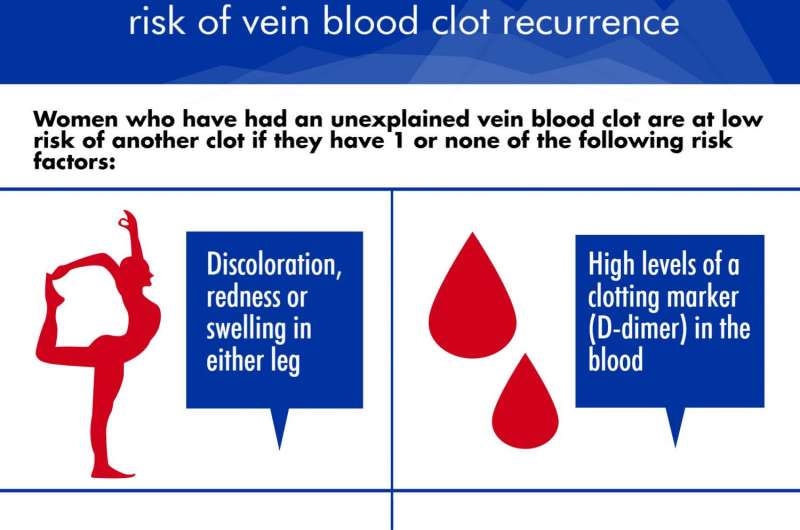A Canadian-led research group has developed and validated a rule that could let half of women with unexplained vein blood clots stop taking blood thinners for life. These findings were published in The BMJ. Credit: The Ottawa Hospital
A Canadian-led research group has developed and validated a rule that could let half of women with unexplained vein blood clots stop taking blood thinners for life. These findings were published in The BMJ.
Over 1.5 million Canadians will experience a vein blood clot their lifetime, known as venous thrombosis. If part of the clot breaks off and travels to the lungs, it can be fatal. Half of these blood clots happen for no apparent reason, and are known as unexplained or unprovoked clots.
Once an unprovoked vein clot is treated, guidelines recommend that patients take blood thinners for the rest of their lives. If they do not, their risk of having a second clot is 30 to 40 percent in the next 10 years. Taking life-long blood thinners virtually eliminates this risk, but comes at a cost of a 1.2 percent chance of major bleeding per year.
"Patients can get very anxious trying to balance the risks of the treatment with the risks of another blood clot," said Dr. Marc Rodger, senior scientist and thrombosis specialist at The Ottawa Hospital and professor at the University of Ottawa. "With this rule we can confidently tell half of the women we see that they are at low risk of having another blood clot. This means they can stop taking blood thinners once their initial clot is treated, sparing them the cost, inconvenience and risks of taking life-long medication."
The HERDOO2 rule, so named to help physicians remember the criteria, was developed by an international team led by Dr. Rodger and published in 2008. According to the rule, if a woman has one or none of the following risk factors she is at low risk for having another blood clot:
Discoloration, redness or swelling in either leg (HER= Hyperpigmentation, edema or redness) High levels of a clotting marker (D-dimer) in the blood Body mass index of 30 kg/m2 or more (Obesity) Older than age 65
The team could not find factors to identify low-risk men.
To confirm that the rule works, Dr. Rodger led an international trial of 2,785 participants with unexplained vein blood clots. They were recruited from 44 health-care centres in 7 countries between 2008 and 2015.
According to the rule, 622 of the 1,213 women in the trial were at low risk of having another blood clot. They were told to stop taking blood thinners after they completed the initial treatment for their first blood clot. For the high-risk patients, the researchers left the decision of continuing blood thinners up the patients and their doctors. Of the 2,125 high-risk patients, 1,802 continued blood thinners while 323 stopped taking them.
The researchers followed these groups for a year after they had finished treatment for their first clot. They found that the low-risk group of women had a 3.0 percent rate of having another blood clot per patient year. This was significantly lower than the 8.1 percent rate among the high-risk patients who had also stopped taking blood thinners.
"We see two to three patients with unexplained blood clots every day at The Ottawa Hospital," said Dr. Marc Rodger, "If this rule was applied across Canada, we estimate that over 10,000 women a year would be identified as low risk and be able to come off blood thinners."
One of these women was Sarah Rodgers, a 38-year-old tattoo artist who took part in the study. The blood clot in her leg was a shock to the active Ottawa woman, who thought that the pain and swelling was a pulled muscle.
"It was so disconcerting—there was nothing I did to make it happen," she said. "My dad's had several strokes and there's heart disease in my family, so it was really scary. I thought I was in for it for the rest of my life."
Once Rodgers finished treatment for the initial clot, she was able to stop taking blood thinners.
"If my blood was too thin, I felt lightheaded. If I wasn't taking enough blood thinner, I would have pains in my leg," she said, "I felt so much better once I came off them."
The rule is now used in all of the health-care centres where it was tested, including The Ottawa Hospital. The researchers' next step is to spread the word to other health-care providers.
Dr. Rodger also wants to raise awareness among patients with this common condition.
"If you are a woman with an unexplained vein blood clot, or on life-long blood thinners because of a past clot, ask your health-care provider about your HERDOO2 score," said Dr. Rodger. "It could save you from a lifetime of medication."
More information: Marc A Rodger et al, Validating the HERDOO2 rule to guide treatment duration for women with unprovoked venous thrombosis: multinational prospective cohort management study, BMJ (2017). DOI: 10.1136/bmj.j1065
Journal information: British Medical Journal (BMJ)
Provided by Ottawa Hospital Research Institute



















